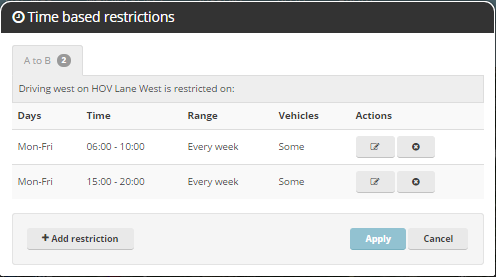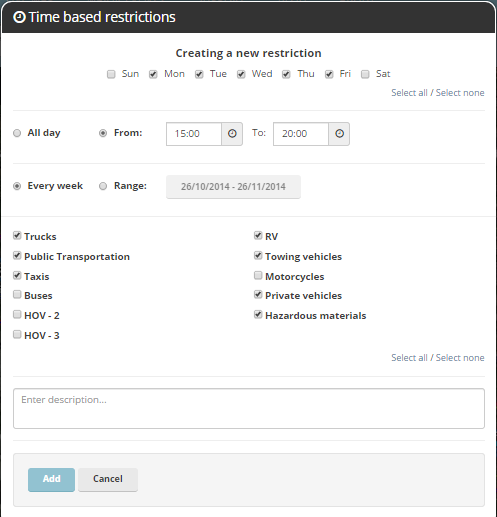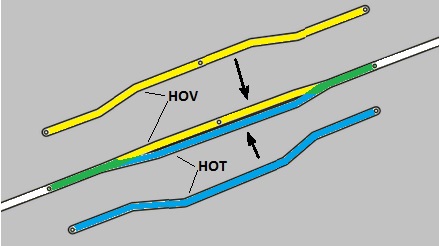Carpool lanes, High-occupancy Vehicle (HOV) lanes, and Transit lanes are road lanes reserved for vehicles meeting special requirements, either carrying at least a specific number of passengers other than the driver, or being a specific vehicle type. The number of required passengers in the vehicle can vary depending on the specific road and time of day.
Although currently Waze does not support the requirements of routing over these types of lanes, there are plans to add support for them in the future.
Supporting these lanes is a priority for Waze, and they are aware of the problems caused by such lanes.
Configuration and setting restrictions
| These guidelines have been written based on the traffic laws governing the Houston Metro's HOV and HOT lanes. While they may be of interest elsewhere be sure to adapt them to the new location's regulations. |
In Houston, Houston Metro has described two different types of high occupancy lanes. There is a Vehicle (HOV) lane which is subjected to restrictions based on time and type of vehicle with number of occupants being a type of vehicle. They also have Toll (HOT) lanes which are time restricted toll roads. What can make the restrictions particularly challenging is that a single lane will often be both a HOV and HOT lane. Metro provides a general description of high occupancy lanes which includes links to the individual lanes where the lane's time based restrictions are described.
Unique factors that should be considered are
- The times on the Metro site specify when it is legal to enter the lane not when a wazer must exit the lane.
- HOT lanes are electronic toll roads. HOV lanes are not toll roads.
- The HOT lane's toll is a fixed amount regardless of how far you drive in the lane.
There was a time when the entire high occupancy lane in waze was restricted to all traffic from 11 AM to 1 PM (the transition window between the end of morning inbound traffic and the start of afternoon outbound traffic). This inadvertently resulted in navigation errors as a vehicle entering the lane at 10:59 AM would be directed to leave the lane at the first opportunity rather than following the best route to the wazer's destination. The solution to this class of issues is to place the time restrictions on the entrances to the high occupancy lanes. Once in the lane there should be no timed based restrictions.
Toll is an attribute applied to a road segment; it can not be turned off and on. Therefore, every high occupancy lane that is both a HOV lane and a HOT lane must have two entrance segments. One tolled for the HOT lane and the other free for the HOV lane. That way, a HOV-2/HOV-3 vehicle may still be directed to use the HOV while avoiding all other tolls roads.
Waze assumes that the tolls paid are proportional to the distance driven yet HOT lanes have fixed tolls. The solution is to keep the length of the tolled segment short so that variations in length between one entrance and the next are negligible in comparison to the distance between the entrances.
As of this time, the waze app does not provide the wazer with the opportunity to specify their vehicle type. Testing has shown that, until that changes, the routing servers presume that all vehicles are Private Vehicles.
Any time you are setting a road to allow HOV - 2, it must also be set to allow HOV - 3.
In Houston car pools, van pools, and motorcycles are allowed to use HOV lanes, therefore when setting partial restrictions to allow HOV-2 (HOV-3), Motorcycles and Buses should also be allowed (unchecked).
Multi-use lanes
Most HOV/HOT lanes are closed outside of specific hours while a few are open to all vehicles outside of the specific HOV/HOT times. In the first case, restrictions can most easily be determined by remembering that its acceptable for restrictions to overlap. For example, a nightly restriction may be applied to every day yet used with an all-day weekend restriction.
Lanes which only have the HOV restrictions in place for certain hours, and are open to all vehicles during other hours, need to have the restrictions HOV vehicle type restrictions on the entrance ramps set to the specific times when the HOV restrictions are being enforced. No other restrictions should be added as the road is unrestricted at all other times.
Example configurations
A multi-use lane which is open to the all vehicles during off-peak hours has to be set as a separate restriction from each of the enforcement periods.
Each of these restrictions must be set to only permit HOV-2, HOV-3, Motorcycles and Buses on weekdays during the hours of 6-10 am, and 3-8 pm.
Lessons Learned
The following concepts were developed after reviewing the HOV/HOT lane restrictions in the Houston area.
Keep each restriction simple
The Houston METRO regulations describe high occupancy lanes in terms of when they are available rather than when they are unavailable (i.e. restrictions) as specified by WME. When inverting the METRO regulations to restrictions approach the task one restriction at a time. If the lane is closed on weekends, that's a restriction. If it is closed to certain classes of vehicles then that's another restriction. Try to avoid having restrictions that specify multiple attributes of days, times, and vehicle types, as they'll be very hard for the next editor to verify. Instead, try to use restrictions that are constrained by only one attribute (days, times, or types).
For example, given an HOV lane that is open from 0500 to 1100 on weekdays to HOV-2 and Motorcycles. The restrictions can be described like this:
- An all day restriction for all vehicle types on Saturday and Sunday.
- An all day, all week, restriction blocking all vehicle types except HOV-2 and Motorcycles.
- We're using an all week restriction here both to keep it simple and to prevent a dependency on the first restriction.
- A weekday restriction for all vehicle types from 1100 to 0500.
Take care when using restrictions spanning midnight
A timed restriction whose stop time is earlier in the day than its start time will begin on one day and continue to the stop time on the next day. If this restriction is then applied to a range of days, for example Monday through Friday, the actual restrictions may not be what was intended. For example, a restriction on 1300 to 0500 Monday through Friday is actually

Viewed this way, its easy to see that the actual restrictions are probably not what the editor expected. Early Monday morning (0000 to 0500) is unrestricted while there is an early morning restriction on the other weekdays. There's also a restriction on Saturday morning which might not be appropriate for that day.
It is possible to apply this type of restriction to weekdays by setting the range to Sunday through Friday if the unintended restrictions to late Sunday and early Saturday are also valid.
Provide specific comments on each restriction
HOV lanes will usually be locked at a high rank to prevent accidental damage to the map. As a result, lower ranked editors are unable to examine the restrictions. For lower ranked editors to assist with resolving HOV-related User Reports those editors must install URO+. URO+ adds a dialog that appears when the editor mouses over a restricted segment which includes the optional comment of each restriction.
With URO+, and specific comments, any editor can see something like

Which is sufficient information for them to determine whether the restrictions played a part in the user's report.
Part-time tolls or HOV/HOT lanes
One of the interesting problems encountered when a single lane is used as both a HOV (restricted by vehicle types and times) lane and as a HOT (part-time toll) lane is that the toll status is an attribute of the road. It can't be enabled, or disable, at arbitrary times. Even if that were to work, enabling toll on a segment meant to be used by HOV traffic would cause routing issues for HOV-2 vehicle with toll avoidance enabled. What is necessary is to split the road for a short distance so that one of the parallel roads can be restricted per the HOV rules while the other road is restricted per the toll rules.
To avoid keep left/right instructions when the driver reaches the "split" road, the segments must overlap at their common junctions as shown in this deconstruction.
Pointers for a complete solution
A complete solution needs to consider the following factors:
- The driver would need to tell the Waze client app how many passengers are present in the car, or what vehicle type they are in for that trip. Waze would only offer routes over carpool lanes when they meet the criteria to be eligible
- In some places, Electric or Plug-in Hybrid vehicles may also use HOV lanes, so this local situation must be known and the driver should be asked if the vehicle is allowed in HOV lanes for reasons other than number of passengers.
- As car pool lanes are often adjacent to normal roads, GPS tracking is not always sufficient to differentiate between the two. For accurate road speeds Waze needs to assume you are using the car pool lane when you have passengers (and/or based on your speed). However if the lanes are separated even by a few meters, the server can usually tell the difference and the speed to the correct lanes, even if the client displays you as being on the wrong lane.
- HOV lanes are being merged with Toll lanes (HOT lanes) and the user needs to be able to select if they want to allow toll roads. The map needs the ability to track multiple lane restrictions (HOV and/or Toll) for the same road rather than defining the road as either an HOV or a Toll lane.


